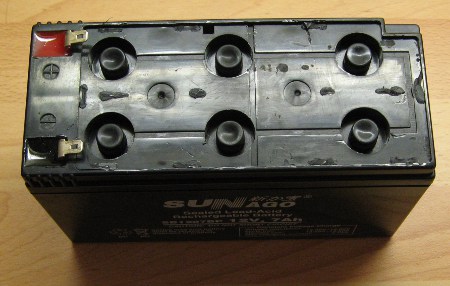Workshop 2010
Regenerating sealed lead acid batteries
By design sealed lead acid batteries are, by their very nature, sealed. This means that if they have been damaged by ovecharging and have dried out then it is problematic to restore them. Ironically it is possible to do this damage in the first place because they aren't completely sealed. There is a rubber cap on top of each cell. This cap is a snug fit but it is not absolutely sealed. If a lead-acid battery is charged too much then the water contained within them can electrolyse to hydrogen and oxygen. This process is called gassing. If the charging isn't too rapid then the hydrogen and oxygen recombine within the cell and re-form to water: no harm done. However, if the charging is far too rapid, the gases are lost around the rubber caps leading to a lower electrolyte level. Ultimately this can destroy the battery and prevent it from holding a charge at all.
Recently, I had a normally faithful torch give up and die. It wouldn't hold any charge and turned off soon after turning it on. It contained a 12V 7Ah sealed lead acid battery. I took the battery out and decided to see if I could repair it.
Investigating the battery
The first thing I did was to pry off the plastic lid covering the 6 cells. This was held on with just some glue and snapped off relatively easily with some forecful jabbing from a screwdriver. If I'm going to re-attach the lid I'll need either some fresh glue or some tape. With the cover removed, you can easily see the 6 cells and their respective rubber caps. It's around these caps that gases will vent if the battery is overcharged.

6-cell sealed lead acid battery with its plastic cover prized off
Read more...First published on 30th December 2010 and last modified on 16th March 2011.
< Newer articles | Older articles >